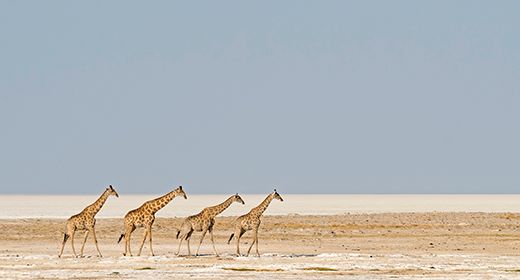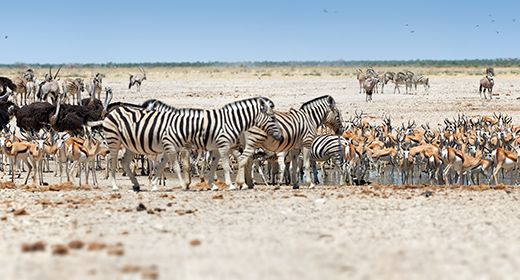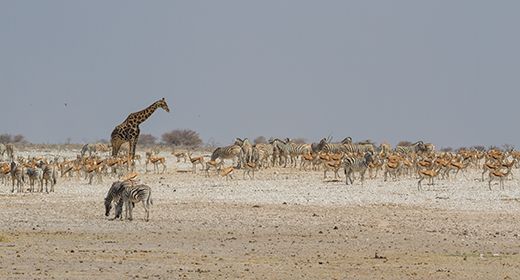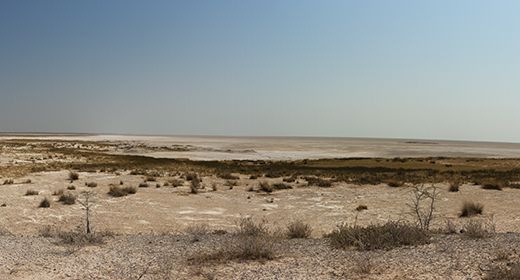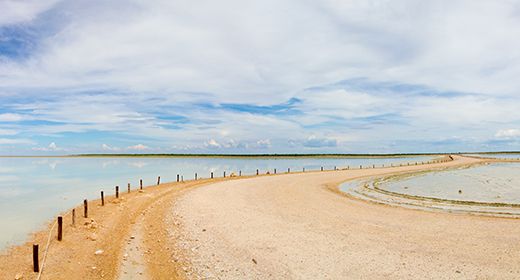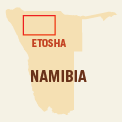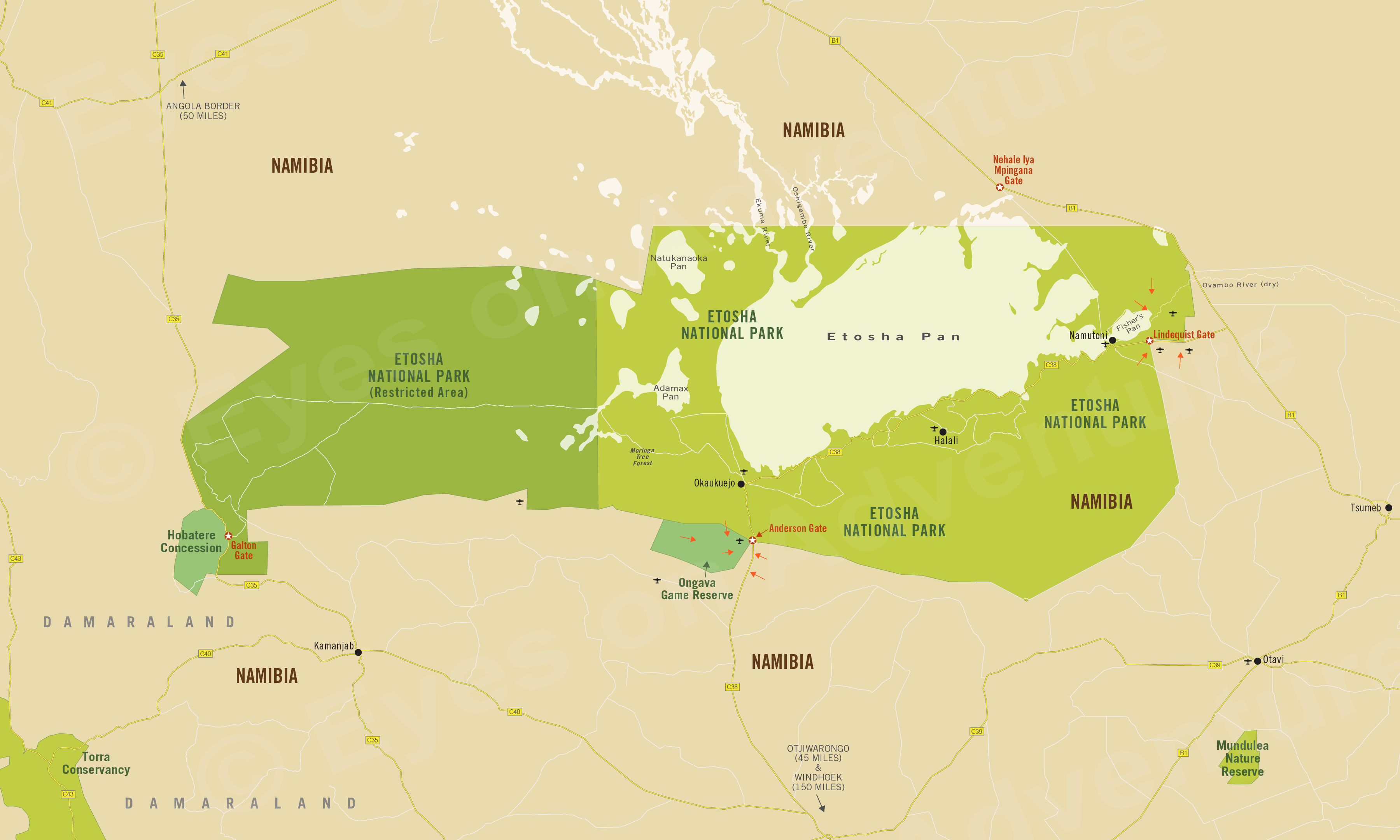Etosha
(incl. Etosha Pan, Ongava Game Reserve)
Region Links: Caprivi / Zambezi, Damaraland & Waterberg, Etosha, Namib Desert & Sossusvlei, Skeleton Coast, Kaokoland & Kunene, Swakopmund, Windhoek
Highlights
- The top wildlife destination in Namibia, with lions, leopards, elephants, rhinos and more
- Watch abundant herds and diverse wildlife in a setting unlike any other
- See the incredible Etosha Pan, the remnant of an massive ancient lake
- Stay in the exclusive Ongava Game Reserve for superb game drives with no national park restrictions
EOA Recommends: Andersson's Camp, Little Ongava, Ongava Game Lodge, Ongava Tented Camp
Based around the massive Etosha Pan, an ancient lake turned salt pan covering roughly 1 900 square miles (5 000 sq kms), Etosha National Park is one of Africa's great wildlife-viewing destinations.

A typical scene during the dry season at an Etosha waterhole
Unlike most wildlife parks in Africa, Etosha is a place of extreme dryness and most game viewing is done while parked next to one of the park's waterholes, where the animals congregate to drink.
Depending on the source, Etosha means 'Place of Mirages', 'Great White Place', or 'Land of Dry Water', and looking across the seemingly endless Etosha Pan, the names are all fitting. The park itself is rarely busy, mostly due to its remoteness, but the wildlife here is abundant and the setting is unlike anything else on the continent.
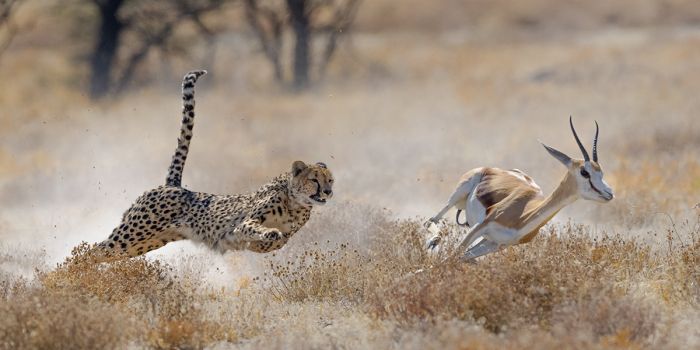
A cheetah in pursuit of a springbok in Etosha National Park, Namibia
Etosha is famous for its large numbers of springbok, oryx, zebra, wildebeest, giraffe, kudu, impala, and ostrich. They can be found crowded together in large numbers as they congregate at waterholes. The springbok often gather in herds numbering in the thousands. Four of the Big Five are found here in good numbers - lion, leopard, elephant, and both species of rhino.
The much smaller Ongava Game Reserve, which borders the park on the south, has several top-notch lodges offering exclusive wildlife safaris to its guests. Lion and rhino viewing in Ongava is exceptionally good.
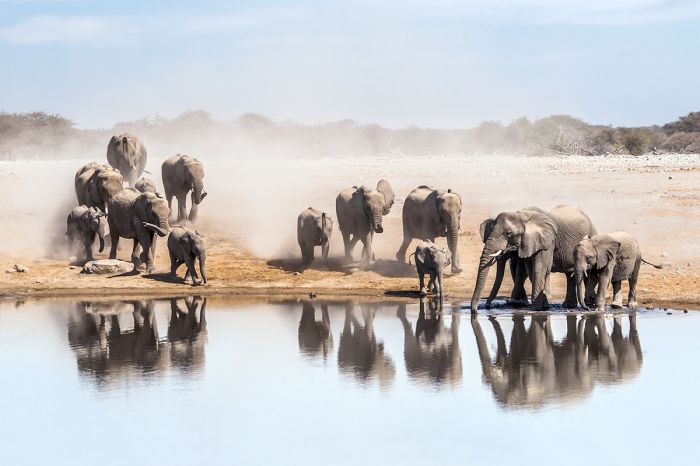
Elephants rush to a waterhole in Etosha National Park
Namibia is not considered a wildlife destination and most tourists visit the country for its incredible scenery, but Etosha is the exception, offering superb game viewing in a spectacular setting.
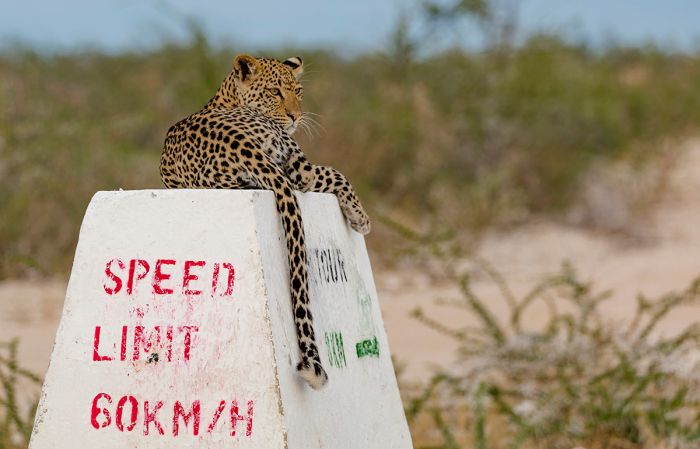
A leopard on the speed limit block in Etosha National Park
Read More...
Geography, History, National Park Rest Camps, Ongava Game Reserve, Private Lodges/Camps, Wildlife
History
The Etosha region has long been inhabited by the Khoisan-speaking tribes as well as the Ovambo people, which inhabited the area north of Etosha Pan. The Ovambo comprise over half of Namibia's current population. The Ovambo have a close cultural and linguistic relationship with the Herero people, which live mostly in the southern parts of Namibia and the Kavango people, which live to the east around the Okavango river.
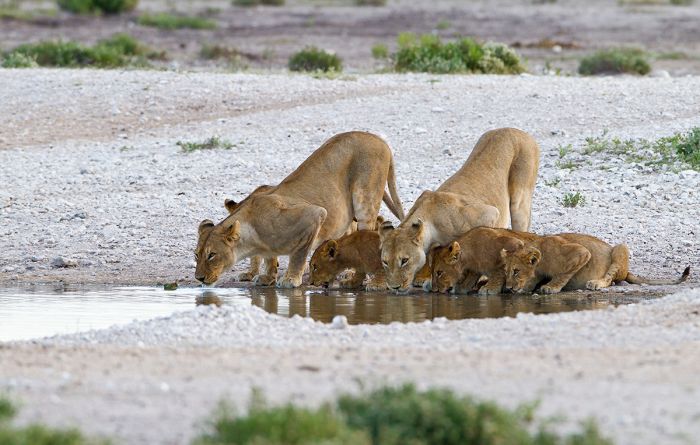
Lions drinking in Etosha
The first Europeans to visit Etosha arrived in 1851, when Charles John Andersson, a Swedish explorer, and Francis Galton (Charles Darwin's cousin) arrived together on a Royal Geographic Society expedition into what was then South West Africa. Their description of the region and its plentiful wildlife led to the subsequent arrival of hunters, who relentlessly slaughtered the animals around Etosha over the following 50 years.
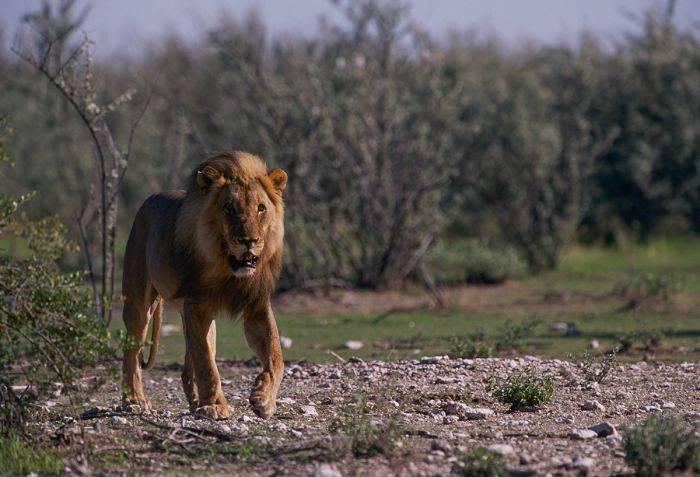
Male lion in Etosha National Park (Copyright © James Weis)
In 1907, in an attempt to stem the rapid decline in wildlife numbers in the northern regions of the country, the Governor of South West Africa declared a massive protected reserve, which included Etosha and ran northwest to the ocean and all the way to the Angola border. The reserve included some of present day Skeleton Coast National Park. This new reserve protected the animals and their seasonal migration routes.
Several changes in the boundaries of the reserve, one in 1958, and another in 1967, reduced the size of Etosha to its present-day size. In 1967, Etosha was granted National Park status.
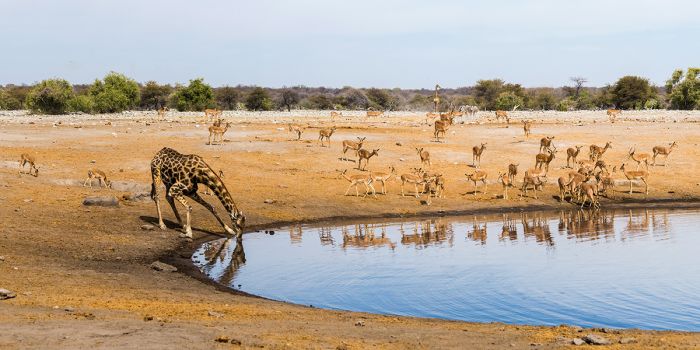
Animals at the Chudop waterhole near Namutoni - Etosha National Park
Geography
The main feature of Etosha is the enormous salt pan, which is the remnant of a large inland lake that has since dried. The pan itself is 80 miles (130 kms) long and 30 miles (50 kms) wide in place, covering 1 826 sq miles (4 730 sq kms). It is by far the largest salt pan in Africa and is easily visible from space. The pan comprises over 20% of the national park.
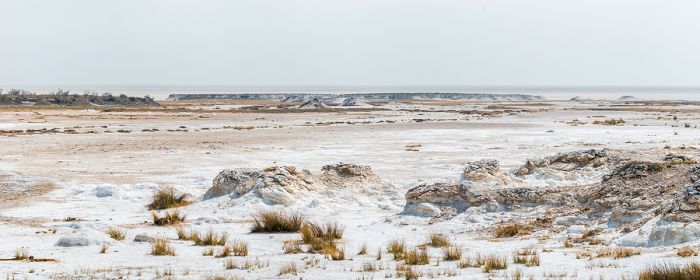
The Etosha Pan on a sunny, winter day
Once fed by rivers flowing south and west, tectonic shifts that occurred millions of years ago changed the flow of many of its source rivers, including the Kunene river, which now flows west into the Atlantic Ocean. Over time, the lake water dried up and today the pan is usually "bone" dry. The evaporation of the lake left behind the minerals from the water, giving the pan its white ethereal appearance.
Etosha Pan does receive some water on occasion. In years when rains in the north are heavy, water flows into the pan via a number of parallel channels extending into Angola, which results in a layer of water, up to 3 feet deep in places that transforms the pan for up to a few months at the beginning of the year. The highly saline quality of this water (often double that of seawater) makes it unfit for animal consumption, but thousands of birds, including flamingos and pelicans, arrive in huge numbers to breed and consume the algae that grows in the water.
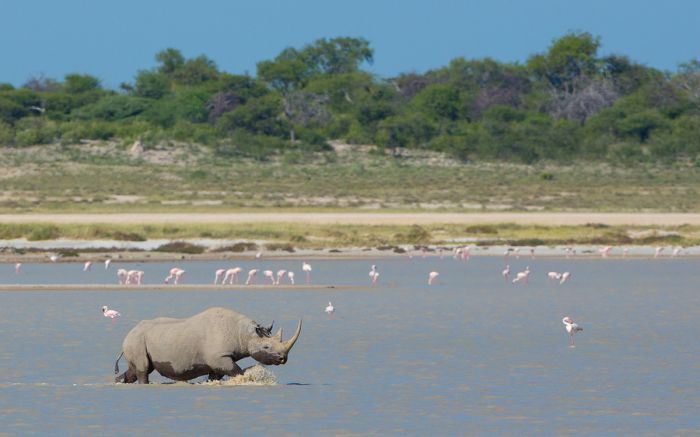
A black rhino crossing Fisher's Pan with flamingos after good rains
Etosha National Park spans roughly 8 600 sq miles (22 300 sq kms) and the area outside the pan is a flat landscape with a variety of different habitats, including mopane tree woodlands and open grassland plains. There are palm trees around the waterholes on the eastern side of the pan around Namutoni. The Moringa Tree Forest is an interesting spot with its contorted trees make for a haunted woodland scene.
The other major feature at Etosha are the numerous waterholes the are concentrated along the southern rim of the pan and along the road to the west that runs into the Restricted Area. The waterholes are mostly natural but some are man-made.
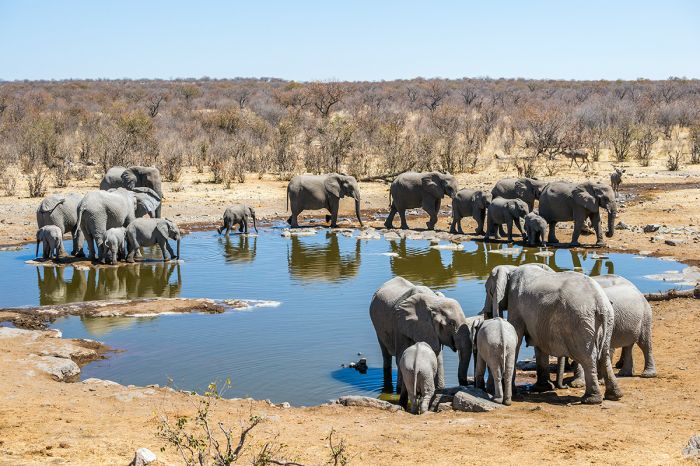
Elephants gathered at the Moringa waterhole near Halali - Etosha National Park
The western side of the park was previously a restricted area, but if you are staying at Dolomite Camp, you will get to enjoy this less-visited portion, which hasn't seen human activity for about 50 years.
Wildlife
The hot daytime temperatures combined with the salty, encrusted surface of the pan make the pan unsuitable for most plants and wildlife to survive there. The only animals that are regularly found on the surface are ostriches, which place their nests several kilometers into the pan to avoid predation. The majority of the animals in Etosha are found along the edges of the pan, where there are numerous spring-fed waterholes, especially along the southern margin.
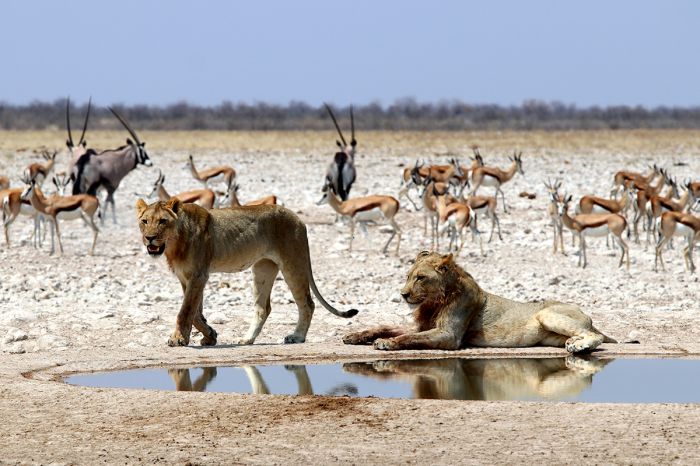
Lions at a waterhole in Etosha National Park
The borders of the pan and the areas beyond support grassland and shrubland vegetation, which support large numbers of giraffe, zebra, blue wildebeest, springbok, oryx, black rhino, white rhino, and ostriches. The accompanying predators include lion, cheetah, leopard, spotted hyena, brown hyena, and black-backed jackal. Other wildlife includes elephant, greater kudu, roan antelope, eland, impala, warthog, steenbok, and many others.
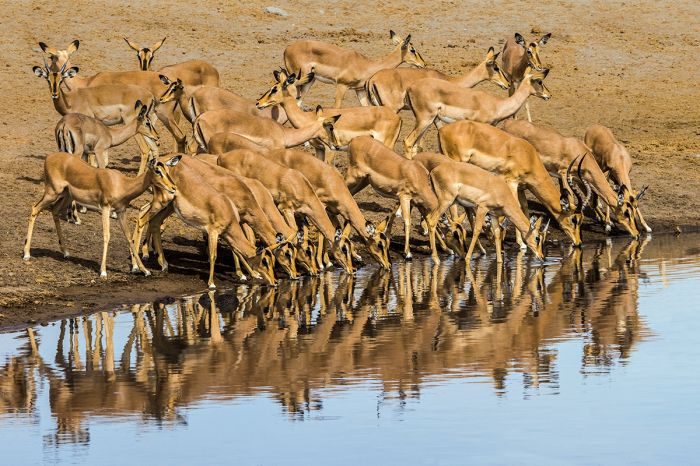
Impalas drinking in Etosha
For birders, there are over 350+ species recorded at Etosha, including the ever-present ostriches, secretarybirds, kori bustards, and black korhaans. The region also boasts numerous dry-land endemics, such as the black-faced and bare-cheeked babblers, Rüppell's parrot, and white-tailed shrike. Raptors may be seen regularly hunting for smaller birds at the waterholes. During years when water flows into the pan (January and February), thousands of flamingos arrive to breed, along with white pelicans, blue cranes, and other waterbirds.
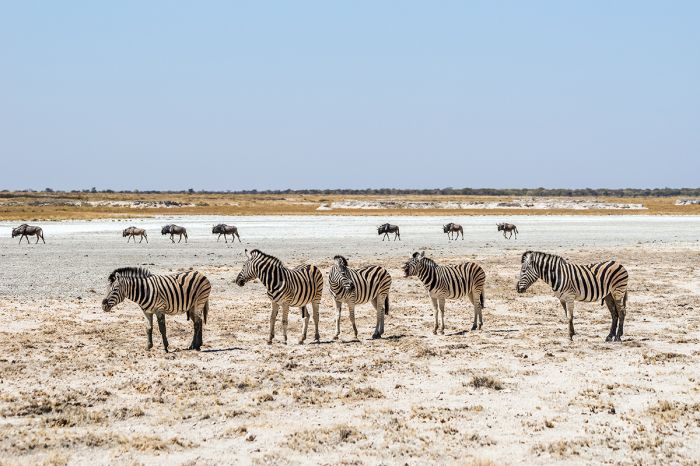
Zebras and blue wildebeests on the Etosha Pan
Wildlife in the park is generally best viewed by visiting the waterholes along the road that traverses the southern edge of the pan. Sitting and waiting is the best tactic.
National Park Rest Camps
There are three national park rest camps, one east at Namutoni, Halali, and Okaukuejo. These are extremely basic camps, with bungalow rooms and simple facilities. There is a camp reception office at each rest camp, plus a restaurant, fuel station, and a shop selling self-catering items like food, drinks, braai (bbq) wood, and other necessities.
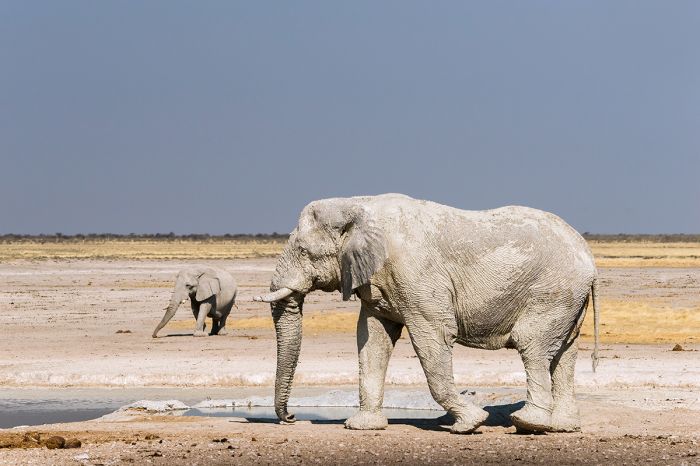
A big bull elephant in Etosha
PRIVATE LODGES AND CAMPS
There are an assortment of private, more upscale lodges and camps, most of them located around Namutoni and Okaukuejo, some inside the national park and some just outside the gate. These camps offer full board and guided game drive options. The previously restricted western portion of the park now has a safari camp, which gives guests a chance to explore this remote and little explored area.
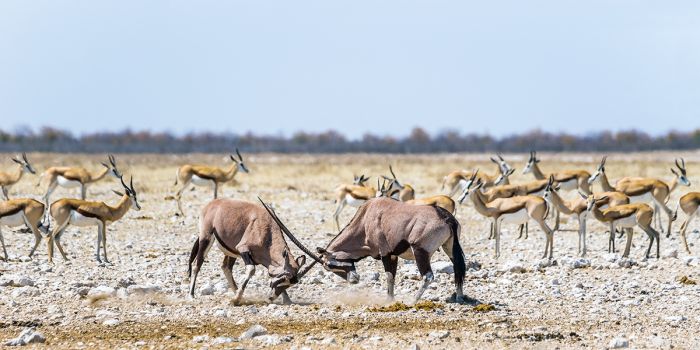
Gemsbok (oryx) and springboks in Etosha
ONGAVA GAME RESERVE
Located southwest of Anderson Gate is the Ongava Private Game Reserve. Previously the location of cattle ranches, the 116-square-mile (300-sq-km) reserve offers three safari lodges and only guests staying in the reserve can enjoy this highly productive game viewing area. Ongava's habitat consists of woodland, bush and has a more hilly landscape than Etosha.
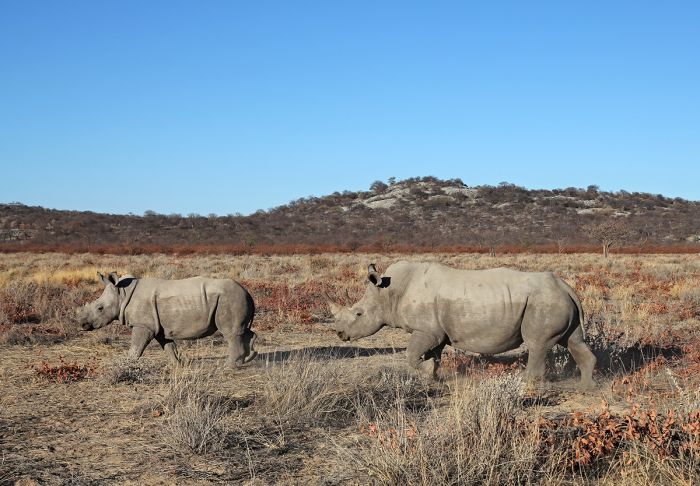
White rhinos in the Ongava Game Reserve
Ongava is one of the last remaining locales in Africa where one can reasonably expect to see both black and white rhino species. Free from the national park restrictions, guests here have the option of game drives past sunset, guided safari walks and off-road driving. Game drives on the reserve and optionally into the national park are offered. The camps have spot-lit waterholes that consistently provide sightings after dark.
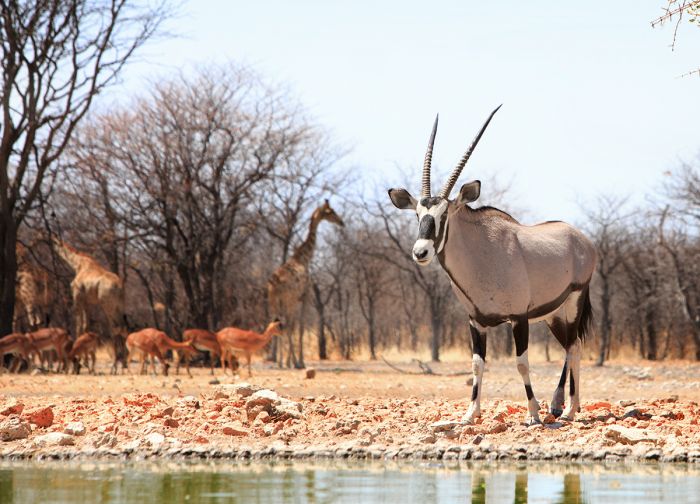
A gemsbok (oryx) at a waterhole in Ongava
Read More...
Geography, History, National Park Rest Camps, Ongava Game Reserve, Private Lodges/Camps, Wildlife
Great Good Fair Poor
- Jan
- Feb
- Mar
- Apr
- May
- Jun
- Jul
- Aug
- Sep
- Oct
- Nov
- Dec
Year-Round Destination
The Etosha region is a destination worthy of a visit regardless of the time of year. Etosha is a semi-desert environment and thus experiences great fluctuations between daytime and nighttime temps. The rains, when they do fall, occur mostly from December thru March, while the rest of the year typically receives little to no rain.
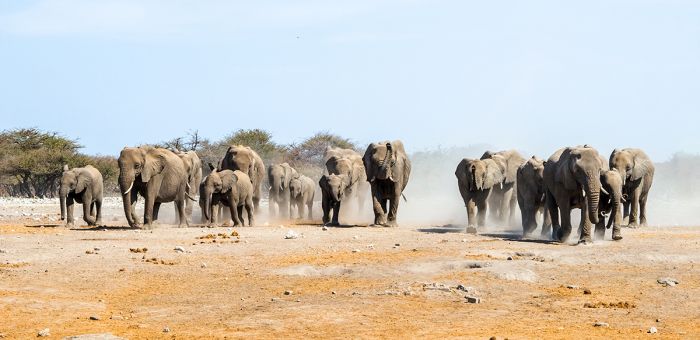
A herd of elephants running to get to a waterhole during the dry season in Etosha
Game viewing is best during the dry months, when large congregations of animals crowd around the national park waterholes. That said, the rainy months can also be spectacular, especially when the Etosha Pan fills with water and the flamingos appear in the thousands to breed.
WINTER/DRY SEASON (MAY TO OCTOBER)
The dry season is from May to December. During these months, the only sources of water for many miles are the series of waterholes along the southern edge of the pan. All of Etosha's wildlife must come to these water sources at least daily, so the game viewing can be nothing short of spectacular for those who have patience. It is not uncommon to see 5 to 10 species all drinking together at a waterhole.
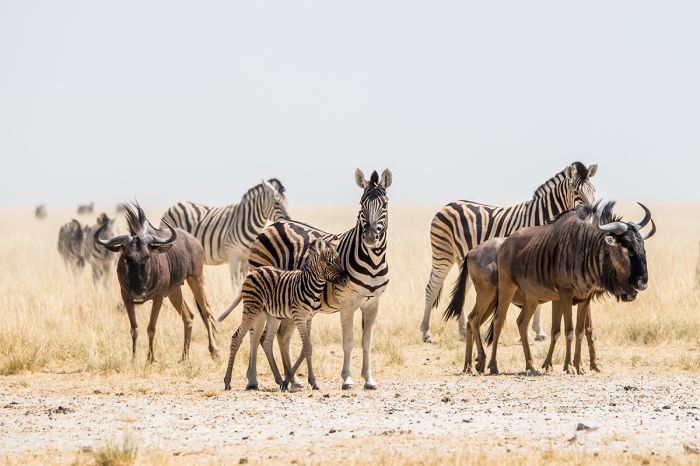
Zebras and wildebeests in Etosha during the dry winter season
In most game reserves in Africa, game viewing becomes less productive during the midday, when temperatures rise and the animals seek shelter, but in Etosha, the animals visit the water holes at all times of the day during the dry season.
The winter days are typically clear and sunny. May thru August very pleasant, with daytime temps averaging a high of 80°F/27°C and nights/early mornings averaging 50°F/10°C. Temps are on the rise in September and October, with daytimes averaging 91°F/33°C and early morning averaging 60°F/15°C. Night drives at this time of year will require dressing in warm layers.
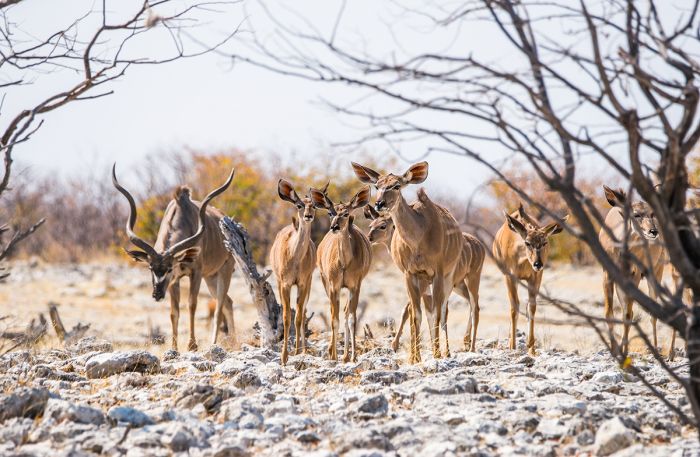
Greater kudus during the dry season in Etosha
SUMMER/WET SEASON (NOVEMBER TO APRIL)
Rains come to Etosha between December and March. Once enough rain has fallen, the smaller and begin to retain water and the animals are less likely to visit the main waterholes that are so bustling with wildlife during the dry months. During this time, the animals disperse and remain spread out in the grassland plains and bush sections around the pan.
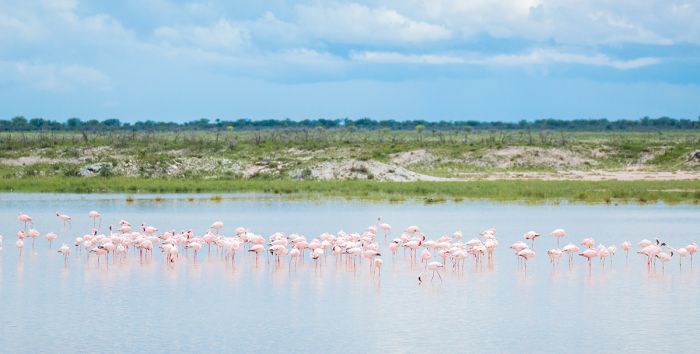
Flamingos in Etosha Pan after good summer rains
Many of the herbivores, including springbok, wildebeest, zebra, and impala, have their babies at this time in order to coincide birth with the availability of fresh grasses for the females to eat and produce fish milk. The area teems with new life during these months and the landscape is transformed from whites and browns to green.
Rains often come in short, powerful afternoon downpours and bring a welcome relief to the summer's hot temperatures. Rains usually appear first in November as an occasional thunderstorm.
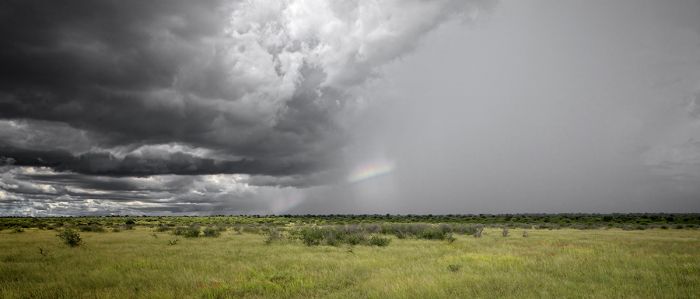
Summer rains in Etosha National Park
In years with good rains further north in Angola, water flows south into the Etosha pan and it becomes a shallow lake. The water attracts thousands of birds, including flamingos, which breed here and feed on the algae in the saline water.
November and December are the warmest months, averaging 91°F/33°C during the day. January thru March experience frequent afternoon downpours, but are otherwise sunny. The daily rains keep the temps in check, with an average daytime temp of 86°F/30°C. April marks the end of the rains and temps are falling.
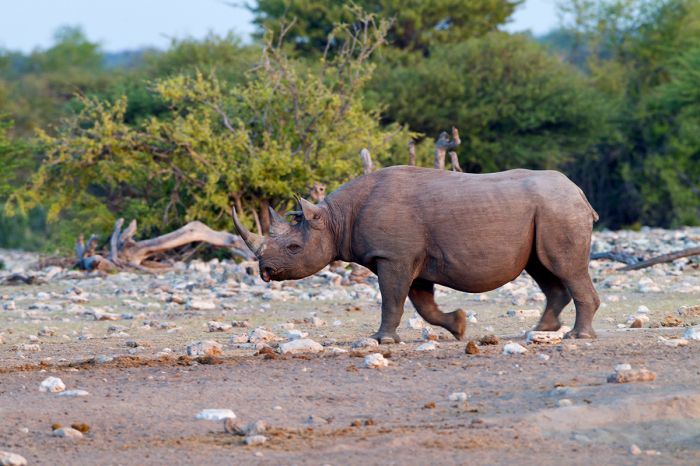
A black rhino with lush green bush during the summer in Etosha




